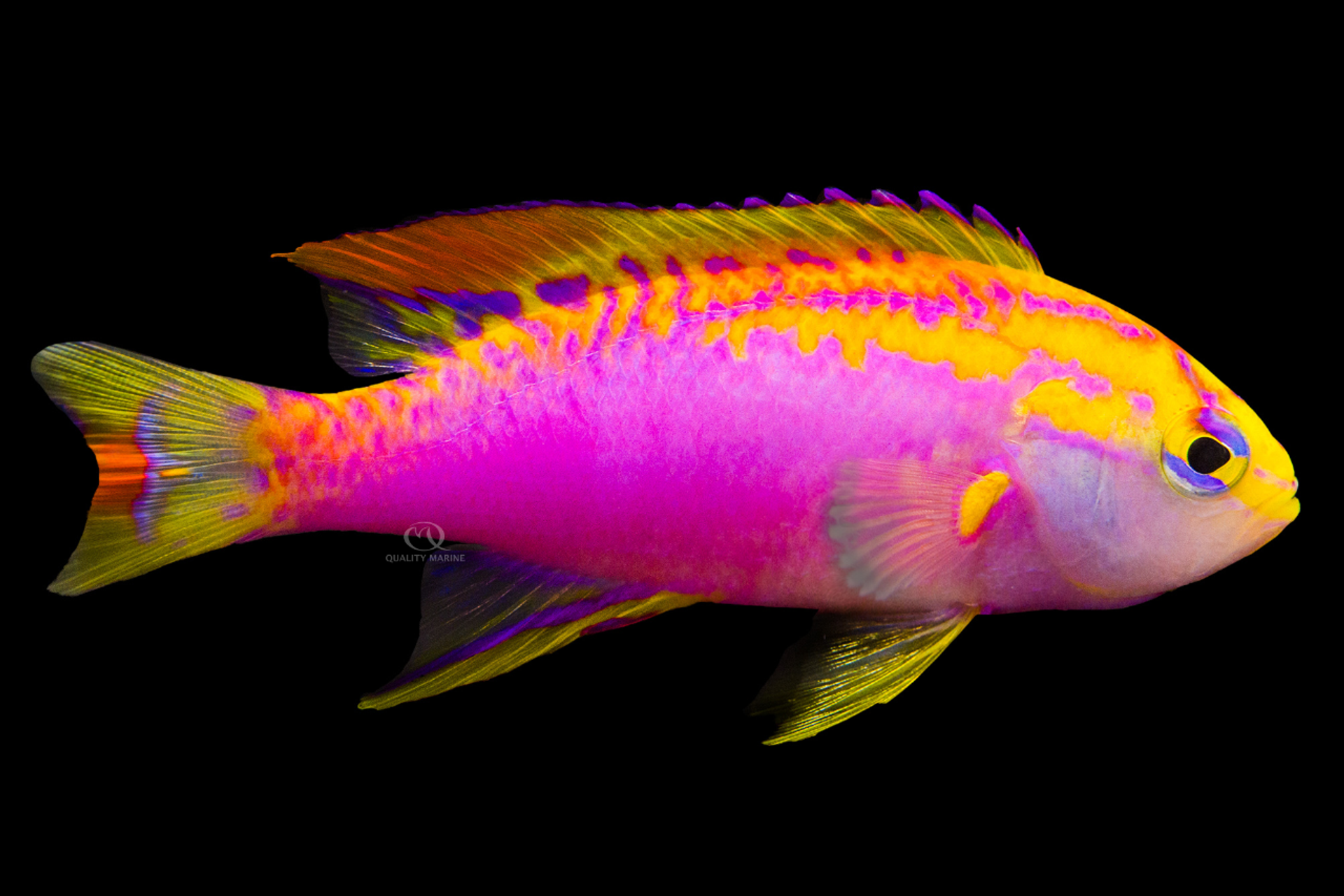We Just Needed to Vent

One of the rarest Anthias you'll see in an aquarium, pretty much everywhere around the globe, is the Ventralis Anthias. They are uncommon and are generally collected from very deep water where they generally stay close to enough cover to effectively hide. When diving to over 300 feet deep, there is a limited amount of time available to the diver at that depth before they need to start surfacing, which itself is a long, slow process dependent on technology and careful planning. This struggle, combined with the remote nature of the locations where Ventralis are found, contributes to their incredible rarity.
Until about 2024 Ventralis Anthias were all part of the much larger genus called Pseudanthias. It has been proposed to move them from this, and our website shows the new genus, Compsanthias. The adoption of new scientific names is sometimes slow, and you'll see the old name and the new name both used. In this new group, Quality Marine has three different Anthias, and the one we're featuring today is the Coral Sea Ventralis (Compsanthias cf. ventralis). While all three Vents feature a purpley/pinky body with a bright yellow back and fins, the Coral Sea variant features some stunning red/orange stripes and spots just under that band of yellow. Have a look at the pictures, and you'll immediately see why everyone adores these fish. Coral Sea Ventralis also get called Longfin Basslets, Longfin Anthias and Longfin Fairy Basslet.
There is a couple species of Anthias that are easier to keep than others but none of them are appropriate for new aquariums and beginner aquarists. This is especially true of Ventralis Anthias. They need mature tanks that are very stable in every way. When you think about the depths that these fish live in, there are a few things that should come to mind. The first is temperature, at 300 feet down the ocean is colder water has lots of oxygen. Your tank should be cooler than what you would usually consider for a tropical reef tank. We advise that you shoot for the upper 60s to low 70s and utilize some forced oxygenation to really crank up the dissolved oxygen level. The next factor about that depth is that it isn't directly affected by solar radiation, waves and tidal action, so the parameters of the water stay incredibly stable in every way. Your aquarium will need to mimic this. Salinity should be rock solid at 1.025 or 1.026, the nitrates should never get above 5ppm, pH should be locked in at 8.2-8.4.
The next most important aspect of keeping Coral Sea Ventralis is feeding them. They have high activity levels and need frequent feeding and will do best with a varied diet. Here we feed them a broad mix of Frozen (thawed) foods from Gamma, that includes Mysis, Brine Plus Spirulina, Brine Plus Omega, Mini Bloodworms, Copepods, Chopped Prawn and Chopped Mussel among others. We feed them three times a day, and you should too (and more wouldn't hurt). They can be trained to take pellet foods, and we have started introducing them to Nutramar Complete here, which is important. High quality pellets deliver more protein and a wider spectrum of nutrients per bite than thawed foods can. They also make it easier to use an auto feeder for the times you aren't around.
All Anthias should be kept in groups that feature three or more females for every male. This means your minimum school should be four, but they'll do much better if you double that. You can also mix them with other peaceful Anthias species to bulk the group numbers up. Each species should have enough females for each male. You can keep a group of all females, and if they are healthy and happy, one of them will slowly transition into a male. Coral Sea Ventralis will only get to be between two and three inches long (maybe a bit more with the flowy tail bits). So, a group of eight could be kept in a tank that was 90 gallons or so. They are great candidates for tall aquariums like the 90 or the 110 tall and 150 tall. The bigger your tank is, the easier it is to maintain the stability the Vents require.
These displays should feature lots of rockwork to supply caves, swim-throughs and plenty of hiding places. They don't need substrate at all. Coral Sea Ventralis are as reef safe as any fish can be. They can be added to any aquarium but will hide the least in tanks that feature dim lighting (also pretty dark 300 feet underwater). They can be acclimated to brighter conditions over time. Vents will do just fine in very high flow, and this will also help with gas exchange and increasing oxygenation in the system.
Ventralis are super peaceful fish and could be kept with a huge variety of tank mates as long as those tank mates like the same conditions and aren't super aggressive themselves. A surprising number of aquarium fish and corals can be kept in lower temperatures than you'd think if you acclimate them slowly to it. This will not be a surprise to anyone who has gone snorkeling in the winter anywhere tropical.
For those of you who are ready, and have an appropriate display, Coral Sea Anthias are some of the most gorgeous fish you can keep. They are the pinnacle of Anthias keeping, and you are sure to have the only ones in your reef-keeping club! Are they easy to keep? No. Are they worth it? Absolutely. If that tank is dialed, and your skills are there, think about asking your Local Fish Store for a harem of Coral Sea Ventralis Anthias from Quality Marine today!